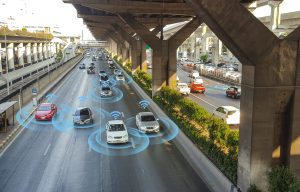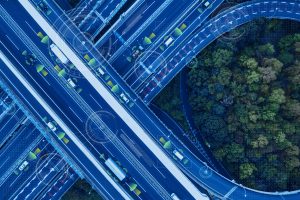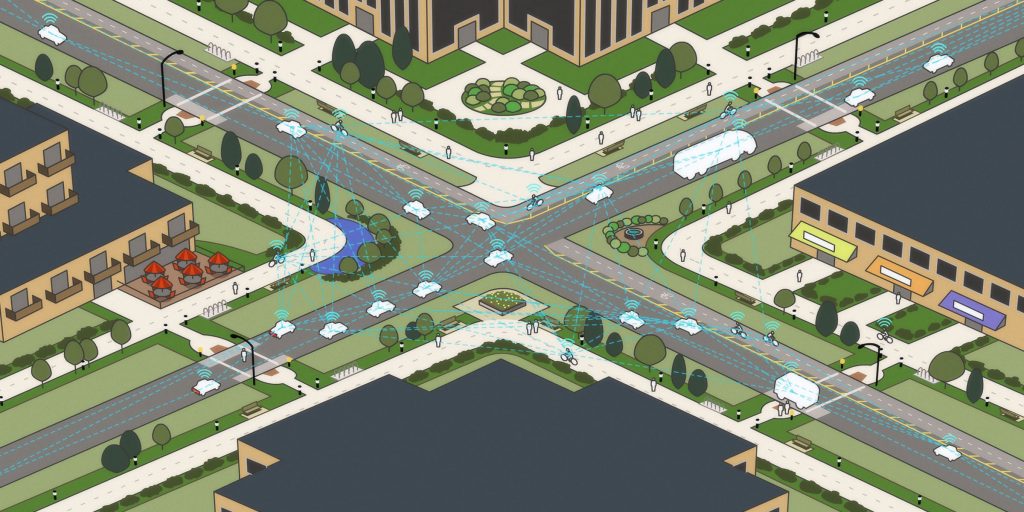The road to tomorrow
Imagine this – instead of waking up an hour early to start your arduous commute to work, fighting traffic the whole way, you hail a car as you’re getting ready using your smartphone. It arrives as you’re walking out your door, and shuttles you to your destination. There is no driver of this vehicle – instead, an array of high-tech tools and sensors keeps the car on its path. In fact, no vehicles on the road are being operated by a human. Traffic is nonexistent, accidents are unheard of and you’re able to relax, have a cup of coffee and start working through your inbox before you even arrive at the office.
It sounds like science fiction, but this future isn’t far off. The Boston Consulting Group estimates that by 2030 almost a quarter of all miles driven in the U.S. will be by shared, selfdriving vehicles. ABI research indicates that in that same time period, 11 million shared driverless vehicles will be on the road globally – about 5 percent of the world’s traffic. And these changes are already occurring; early this month, Alphabet’s Waymo unit announced self-driving vehicles will be available in the Phoenix area through the ride-hailing service Lyft.
“As a first step, we’ll deploy 10 Waymo vehicles on Lyft over the next few months,” Waymo CEO John Krafcik wrote in a post on Medium. “Once Waymo vehicles are on the platform, Lyft users in the area will have the option to select a Waymo directly from the Lyft app for eligible rides.”
Clearly, this technology is already out there – communities just need to figure out how to best utilize it. Experts agree driverless vehicles will signal a new era in transportation, but unless local leaders begin to plan for this future, putting thoughtful policy in place and creating the proper infrastructure, what should be a science fiction dream could turn into a dystopian nightmare.
The driverless dream

Smart car, self-driving mode vehicle with Radar signal system and and wireless communication, Autonomous car
Sam Schwartz, author of “No One at the Wheel: Driverless Cars and the Road of the Future,” and former chief traffic engineer for New York City’s Department of Transportation, makes the argument that cities should not let these technologies evolve organically. Local leaders need to be proactive and take control of the future of Transportation in their communities, or else.
He lays out three scenarios in his book – what he calls the good, the bad and the ugly. The best outcome he foresees is that leaders begin now to shift the public’s desire for privately owned vehicles toward what he calls autonomous micro transit – essentially, autonomous vehicles should be fleet-owned and used as first-mile/ last-mile solutions to support existing public transportation systems.
A worse outcome, Schwartz says, would be fleet-owned autonomous vehicles operating independently of a greater mass public transit system. This would be likely to be the result of overconfidence in autonomous vehicles’ ability to increase roadway capacity. Some experts argue that since autonomous vehicles remove the potential for human error, they would be able to follow each other more closely, essentially mimicking the capacity of a bus or train line.
“There’s no way they could come close,” Schwartz says, “Maybe you’ll increase capacity to the point that each vehicle is one second apart – that’s 3,600 vehicles per hour per lane. This doesn’t mean we’ve increased the person capacity because some of those vehicles will be empty going to pick someone up or leaving someone they just dropped off.”
This would essentially be history repeating itself. “We lost so much good transit when the automobile came on the scene,” he says. “We bought hook line and sinker that we could solve our transportation problems with the automobile and building roadways. A lot of places tried that – look at Los Angeles… once had the best transit system in the country… now the traffic is horrendous.” Schwartz cautions local leaders to think critically about how autonomous vehicles could support mass transit, not replace it.
The worst outcome Schwartz envisions is letting autonomous vehicles hit the streets with minimal thought regarding their impact. These vehicles would be privately owned, and greatly increase congestion in urban areas.
“Let’s say someone comes to visit me in Midtown Manhattan. You tell the car to go park, the car says it’s $50 dollars to park, sorry,” Schwartz laughs. “So, you tell the car to go home – now you have double the miles in that case. Our nature as human beings is to do what’s best for us as individuals and not necessarily what’s best for society, so we’re going to have so many zombie cars zooming all around doing what’s most convenient for the owner, adding lots of traffic, creating more gridlock than it solves. That’s a future I worry about.”
One thing seems to be certain, though – this future is coming, and it’s going to be disruptive.
Designing the future

Automotive technology concept. ITS (Intelligent Transport Systems). ADAS (Advanced Driver Assistance System).
One of the first major ways driverless vehicles will impact our streets is in their design. Generally speaking, Tom Sohrweide, a transportation and traffic engineer consultant for Short Elliott Hendrickson, anticipates these technologies will facilitate the narrowing of roadways, freeing up more space for pedestrians, bikes, scooters and other forms of alternative transportation.
Today’s roadways and intersections are designed to move human-operated vehicles during peak congestion hours. These roadways usually have multiple lanes for traffic and dedicated turn lanes adding to their footprint. Pedestrians cross at intersections controlled by timed signals. Parking lots flank most roadways, providing access to retail and residential spaces. Simply put, a lot of our landscapes – particularly in urban environments – are paved, Sohrweide says.
However, when the capabilities of driverless cars are taken into consideration in the design process, roadways can start to change. “With automated vehicles, we would anticipate the headways [the space between two traveling vehicles] would be greatly reduced,” Sohrweide says. “By platooning vehicles more, less roadway needs to be used. Instead of things being spread out, they can be consolidated which can, in turn, relate to fewer lanes. Speed differentials will be better controlled – if you get people going the same speed that would also impact roadway capacity.”
The need for parking will also be greatly reduced, Sohrweide says. If fleets of driverless cars operate like a modern transit system with the ability to pick up and drop off passengers continuously, the need for parking lots would be greatly reduced, and these lots could become more remote. This, in turn, would change the way urban landscapes are developed. Without the need for massive parking lots and huge parking decks, city planners could focus on better uses for these plots of land.
Cornell Robertson, Franklin County, Ohio engineer, agrees that considerations need to be taken now to prepare for a driverless future. One of the biggest challenges he sees for his community, however, is preparing all the various types of roadways that the county owns.
“We have a wide range of roadway types – we have urban roadways that are curb and gutter streets, but we also have rural routes that don’t necessarily have curb and gutter but have striping. We also have rural routes that don’t have striping,” Robertson says. “We have school zones, we have railroad crossings – all these various road types are going to be important to study, and we’re going to have to account for all these variations.”
He’s also concerned about how the patterns of roadway deterioration will change as automation becomes more prevalent. “We have to be careful. When driving becomes automated, there’s a likelihood that the variability of driving will be removed. This will allow for narrower roadways, but if that variability is removed from how vehicles are driven, that will increase the localized wear and tear. This could mean the vehicles – from one car to the next – are traveling over the exact same wheel paths… It’s a nice idea that roadways could be narrowed, but there could be a tradeoff to that concept.”
This shift would necessitate changes in the ways roads are constructed and maintained. Robertson says his county is already exploring innovative ways to make repairs, including chip and seal. As opposed to milling out a roadway and resurfacing it, an emulsion is laid down on the surface and an aggregate is placed into the emulsion. The roadway is then brushed to remove excess materials and a layer of sealant is applied. This method is much faster and much cheaper, Robertson says. It’s a simple concept, but the individual components of the process have been dramatically improved over the years.
Robertson says the county is also exploring ground rubber tire fibers being added into asphalt mixes. This is an environmentally friendly concept that minimizes the number of old tires going into landfills, and could potentially be a way to create more durable roadways in the future.
This new construction and the redesign of existing roadways will, of course, demand funding; however, as technologies change, our current funding models are becoming outdated. This begs the question – how are we going to pay for this?
Funding the future
Kevin Stone, executive director of the National Association of County Engineers, says the most pervasive model for funding roadways in this country is through gas taxes; however, as fuel efficiencies improve, more hybrid vehicles take to the road and alternative-fuel vehicles become more popular, the revenue generated by this tax is becoming diminished, and communities are barely able to keep up with necessary repairs.
“As technology improves, whether it be fuel standards, autonomous vehicles, intelligent transportation systems or smart vehicle technology, your gas tax money is dwindling,” Stone says. “A lot of the ideas coming out of Congress right now are moving toward vehicle miles traveled, or the VMT model… You’re paying by the mile.”
This essentially sets up roadway infrastructure funding like a utility – the heaviest users pay the most. It’s a more equitable, more up-to-date funding method that Michelle Godfrey, public information officer for Oregon’s Department of Transportation, hopes will become more popular as transportation methods evolve.
Oregon is the first state in the country to launch a fully operational vehicle-miles-traveled tax program. OreGO launched on July 1, 2015, the pilot program is the first to actually use real drivers to collect real data in real time and collecting real money. However, as the program is in its infancy, it’s on a voluntary basis and is limited to 5,000 vehicles, Godfrey says.
“The program isn’t intended to generate any significant revenue like the gas tax does,” Godfrey says. “We like to call it a test run of the system.”
So far, it’s been a resounding success. Godfrey says they’ve been able to demonstrate functionality with every aspect of the system, from customers interacting with third-party account managers to transferring funds into the state treasury.
The program works by having drivers plug a device into their vehicle’s data port, similar to what’s used for pay-as-you-go insurance models. That device connects wireless to transmit mileage and fuel consumption data back to a third-party account manager. That data is then used to determine how much fuel tax was paid versus how much is owed based on a rate of 1.7 cents per mile. The fuel taxes paid are then credited against the road usage charge. If the customer is owed once this calculation is complete, they are issued a voucher for the difference. Most in the program, however, just about break even.
So why would anyone volunteer to pay an extra tax? Godfrey admits there’s little incentive currently, aside from participating in a program that will likely be the framework for funding roadways in the near future. “These are people that are interested in road use charging,” Godfrey says. “They are thought leaders, technology leaders. They are curious about how it works. It’s not sustainable as a voluntary program, though.”
One issue the pilot program is revealing, however, is that public perception has a lot to do with the success of such a funding method. Currently, it seems people think that if they live in a more rural area and have to drive further distances, they’ll be disadvantaged by such a tax. Godfrey, however, says this isn’t necessarily the case.
“The gas tax is a proxy for a per-mile charge, so they’re already paying more than they would under a road-charge system because they’re consuming more fuel,” Godfrey explains. “They’re already subsidizing current [lower mileage] drivers. That’s why the current gas tax has become so unfair – because so many vehicles on the road are getting such wildly different fuel efficiencies.”
Another issue with perception that needs to be addressed is the “big brother” spookiness of willfully putting a government-issued tracking device into a private vehicle. This will take public education campaigns to overcome, Godfrey says. While OreGO does collect location data, this data is collected only by the third-party account manager, meaning it never reaches the government and is destroyed by law within 30 days. While people were wary at first, Godfrey says that trepidation is waning.
“As people become more comfortable and familiar with using GPS and other similar devices, they have less objection to having this device in their vehicle,” Godfrey says. “When they try the program, they understand how it gives them added value – there are all kinds of other services they can get from their account manager aside from the tax program.” For example, users can track their vehicle if its stolen, they can geofence their vehicle so their teen driver can’t stray too far from home and they can receive critical service updates and component failure warnings.”
While these hurdles might be difficult to clear, Godfrey thinks this model will likely become more popular as vehicle technology advances. “This is a modern technology that addresses the funding problems based on how drivers operate today,” she says. “The gas tax is based on how things worked 100 years ago. The future of transportation demands a modern technological solution. We think this is the most fair.”
Preparing for the future
In an article he wrote regarding the transition to driverless vehicles, Sohrweide offers two pieces of advice for local leaders. First, he encourages them to stay informed and be proactive. Although we’re still about a decade away by most experts’ estimates, it’s important to stay up to date on how these technologies are being developed, where they are being deployed and the lessons that are already being learned. Several states have established advisory boards on the topic – such as Minnesota’s Governor’s Advisory Council on Connected and Automated Vehicles. He encourages local leaders to seek out such resources.
Second, Sohrweide says communities need to be intentional but realistic about the roadways they are designing today. Citing data from the National League of Cities, he says only 6 percent of major U.S. cities’ long-range transportation master plans are considering the challenges of automated vehicles. Ignoring the issue is folly. Today’s roads need to be designed with this future in mind. Focusing on a more equal mix of transportation modes, prioritizing pedestrian and cycle traffic and anticipating the needs of tomorrow’s vehicles will position communities to better handle the challenges ahead.




















